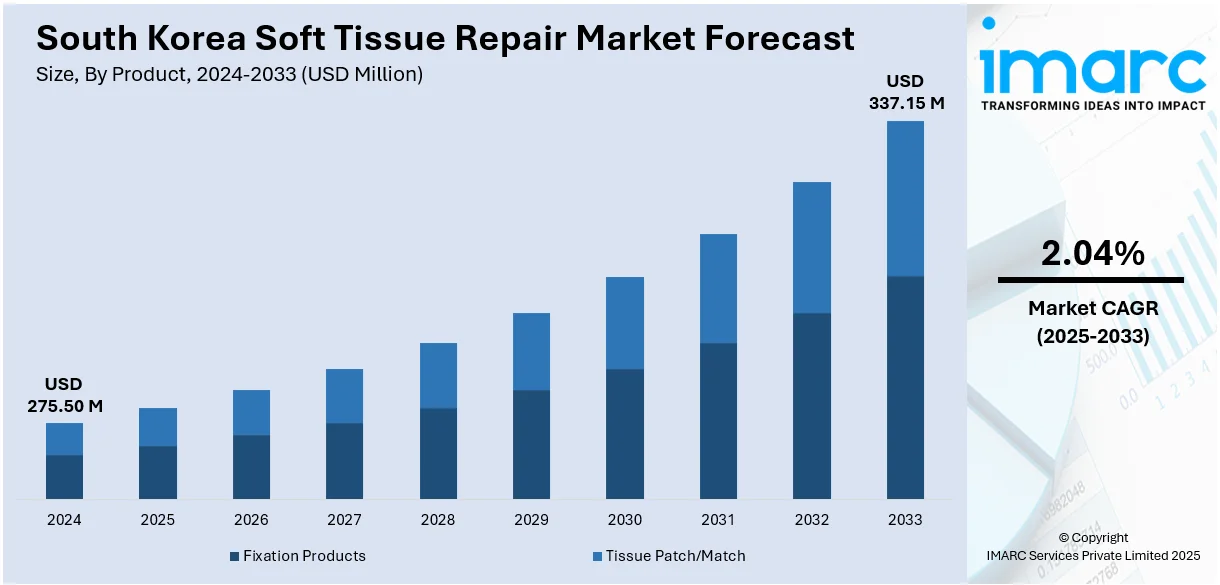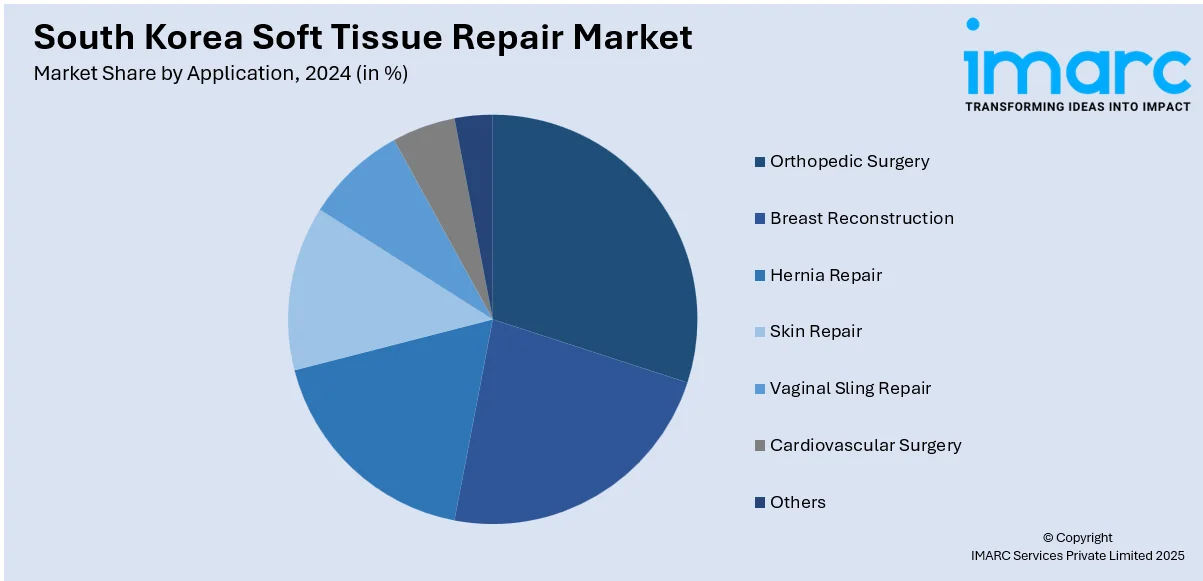
South Korea Soft Tissue Repair Market Size, Share, Trends and Forecast by Product, Application, End Use, and Region, 2025-2033
South Korea Soft Tissue Repair Market Overview:
The South Korea soft tissue repair market size reached USD 275.50 Million in 2024. The market is projected to reach USD 337.15 Million by 2033, exhibiting a growth rate (CAGR) of 2.04% during 2025-2033. The market is evolving to advance surgical techniques and biomaterials. Surgical meshes, sutures, and tissue scaffolds are widely applied in hernia repair, sports trauma, and wound care. Enhancement of minimally invasive (MI) technology is improving recovery and clinical outcomes. Healthcare providers, including hospitals and ambulatory surgery facilities, are adopting these solutions for enhanced patient care. Strategic alliances and expanding health care knowledge are key drivers of expansion in the market share for the South Korea soft tissue repair market.
|
Report Attribute
|
Key Statistics
|
|---|---|
|
Base Year
|
2024 |
|
Forecast Years
|
2025-2033
|
|
Historical Years
|
2019-2024
|
| Market Size in 2024 | USD 275.50 Million |
| Market Forecast in 2033 | USD 337.15 Million |
| Market Growth Rate 2025-2033 | 2.04% |
South Korea Soft Tissue Repair Market Trends:
Expansion of Regenerative Medicine Access
In February of 2025, South Korea enacted the Act on the Safety of and Support for Advanced Regenerative Medicine and Advanced Biological Products. This legislation allows patients to receive pioneering cell and gene therapies beyond clinical trials if they are suffering from severe, rare, or untreatable diseases. Now, over 100 medical facilities are approved under this provision, which is managed by a national committee within the Ministry of Health and Drug Safety. This framework of regulation weighs severe safety standards against expedited patient access, with more hospitals providing regenerative therapy for soft tissue repair, e.g., cartilage regeneration and tendon regeneration. Moreover, this growth has seen more government investment in advanced therapies that have expanded research and clinical use. Hospitals are now better positioned to manage complex soft tissue injuries using these innovative therapies, marking a significant improvement in treatment choices. The synergy of regulatory endorsement and institutional preparedness is fueling broader use of regenerative medicine, making South Korea a pioneer in this area.

To get more information on this market, Request Sample
Innovative Biomaterial Applications
In November 2024, researchers at Pohang University of Science and Technology (POSTECH) introduced a novel microneedle bandage combining mussel adhesive proteins and silk fibroin for cardiac tissue regeneration. Although initially developed for myocardial repair, this technology shows promising potential for broader soft tissue applications, including tendons, ligaments, and skin. The bandage supports tissue regeneration by mimicking the natural extracellular matrix and delivering therapeutic agents in a precise and sustained manner. This innovation reflects South Korea’s growing focus on biomaterials that are versatile and biologically active, which can enhance healing and improve surgical outcomes. Collaboration between academia and industry has accelerated the translation of such research into clinical trials and, eventually, routine care. These cutting-edge materials not only represent technological advancement but also signify a shift towards smarter, more effective solutions in soft tissue repair. The continued development and clinical adoption of such biomaterials contribute significantly to the South Korea soft tissue repair market growth, reinforcing the country’s role as an innovation hub in regenerative medicine.
Advanced Cell‑Seeded Therapies in Wound Care
South Korea is pioneering the use of cell-seeded artificial dermis grafts to improve wound healing outcomes. These grafts, composed primarily of fibroblasts and keratinocytes, have received Korean FDA approval and are increasingly used to treat chronic wounds such as diabetic foot ulcers. Both autologous (patient-derived) and allogeneic (donor-derived) therapies have demonstrated clinical effectiveness by reducing healing times and minimizing scarring, which is crucial for improving patient quality of life. Government support and regulatory approvals have facilitated the wider integration of these therapies into public healthcare settings, expanding accessibility. This emphasis on biologics and regenerative wound management highlights a broader trend towards advanced, personalized treatments in soft tissue repair. Clinicians are now able to offer more targeted and effective care, resulting in faster recovery and better cosmetic outcomes. These developments exemplify South Korea soft tissue repair market trends, showcasing the country’s commitment to advancing regenerative medicine through innovation, regulation, and practical application.
South Korea Soft Tissue Repair Market Segmentation:
IMARC Group provides an analysis of the key trends in each segment of the market, along with forecasts at the country and regional levels for 2025-2033. Our report has categorized the market based on product, application, and end use.
Product Insights:
- Fixation Products
- Suture
- Suture Anchors
- Others
- Tissue Patch/Match
- Biological
- Synthetic
The report has provided a detailed breakup and analysis of the market based on the product. This includes fixation products (suture, suture anchors, and others) and tissue patch/match (biological and synthetic).
Application Insights:

- Orthopedic Surgery
- Breast Reconstruction
- Hernia Repair
- Skin Repair
- Vaginal Sling Repair
- Cardiovascular Surgery
- Others
A detailed breakup and analysis of the market based on the application have also been provided in the report. This includes orthopedic surgery, breast reconstruction, hernia repair, skin repair, vaginal sling repair, cardiovascular surgery, and others.
End Use Insights:
- Hospitals and Clinics
- Research and Academic Institutes
- Others
The report has provided a detailed breakup and analysis of the market based on the end use. This includes hospitals and clinics, research and academic institutes, and others.
Regional Insights:
- Seoul Capital Area
- Yeongnam (Southeastern Region)
- Honam (Southwestern Region)
- Hoseo (Central Region)
- Others
The report has also provided a comprehensive analysis of all the major regional markets, which include the Seoul Capital Area, Yeongnam (Southeastern Region), Honam (Southwestern Region), Hoseo (Central Region), and others.
Competitive Landscape:
The market research report has also provided a comprehensive analysis of the competitive landscape. Competitive analysis such as market structure, key player positioning, top winning strategies, competitive dashboard, and company evaluation quadrant has been covered in the report. Also, detailed profiles of all major companies have been provided.
South Korea Soft Tissue Repair Market News:
- January 2024: South Korean biotech startup PLCOSKIN has gained attention for its innovative 3D-printed soft tissue reconstruction device, TissueDerm. Developed using biocompatible materials like polycaprolactone and collagen, TissueDerm aims to enhance tissue regeneration in breast reconstruction procedures. The company has secured regulatory approval from South Korea’s Ministry of Food and Drug Safety, positioning it for commercial launch within the country. PLCOSKIN’s advancements reflect South Korea’s growing expertise and leadership in regenerative medicine and biomedical engineering.
South Korea Soft Tissue Repair Market Report Coverage:
| Report Features | Details |
|---|---|
| Base Year of the Analysis | 2024 |
| Historical Period | 2019-2024 |
| Forecast Period | 2025-2033 |
| Units | Million USD |
| Scope of the Report |
Exploration of Historical Trends and Market Outlook, Industry Catalysts and Challenges, Segment-Wise Historical and Future Market Assessment:
|
| Products Covered |
|
| Applications Covered | Orthopedic Surgery, Breast Reconstruction, Hernia Repair, Skin Repair, Vaginal Sling Repair, Cardiovascular Surgery, Others |
| End Uses Covered | Hospitals and Clinics, Research and Academic Institutes, Others |
| Regions Covered | Seoul Capital Area, Yeongnam (Southeastern Region), Honam (Southwestern Region), Hoseo (Central Region), Others |
| Customization Scope | 10% Free Customization |
| Post-Sale Analyst Support | 10-12 Weeks |
| Delivery Format | PDF and Excel through Email (We can also provide the editable version of the report in PPT/Word format on special request) |
Key Questions Answered in This Report:
- How has the South Korea soft tissue repair market performed so far and how will it perform in the coming years?
- What is the breakup of the South Korea soft tissue repair market on the basis of product?
- What is the breakup of the South Korea soft tissue repair market on the basis of application?
- What is the breakup of the South Korea soft tissue repair market on the basis of end use?
- What is the breakup of the South Korea soft tissue repair market on the basis of region?
- What are the various stages in the value chain of the South Korea soft tissue repair market?
- What are the key driving factors and challenges in the South Korea soft tissue repair market?
- What is the structure of the South Korea soft tissue repair market and who are the key players?
- What is the degree of competition in the South Korea soft tissue repair market?
Key Benefits for Stakeholders:
- IMARC’s industry report offers a comprehensive quantitative analysis of various market segments, historical and current market trends, market forecasts, and dynamics of the South Korea soft tissue repair market from 2019-2033.
- The research report provides the latest information on the market drivers, challenges, and opportunities in the South Korea soft tissue repair market.
- Porter's five forces analysis assist stakeholders in assessing the impact of new entrants, competitive rivalry, supplier power, buyer power, and the threat of substitution. It helps stakeholders to analyze the level of competition within the South Korea soft tissue repair industry and its attractiveness.
- Competitive landscape allows stakeholders to understand their competitive environment and provides an insight into the current positions of key players in the market.
Need more help?
- Speak to our experienced analysts for insights on the current market scenarios.
- Include additional segments and countries to customize the report as per your requirement.
- Gain an unparalleled competitive advantage in your domain by understanding how to utilize the report and positively impacting your operations and revenue.
- For further assistance, please connect with our analysts.
 Request Customization
Request Customization
 Speak to an Analyst
Speak to an Analyst
 Request Brochure
Request Brochure
 Inquire Before Buying
Inquire Before Buying




.webp)




.webp)












